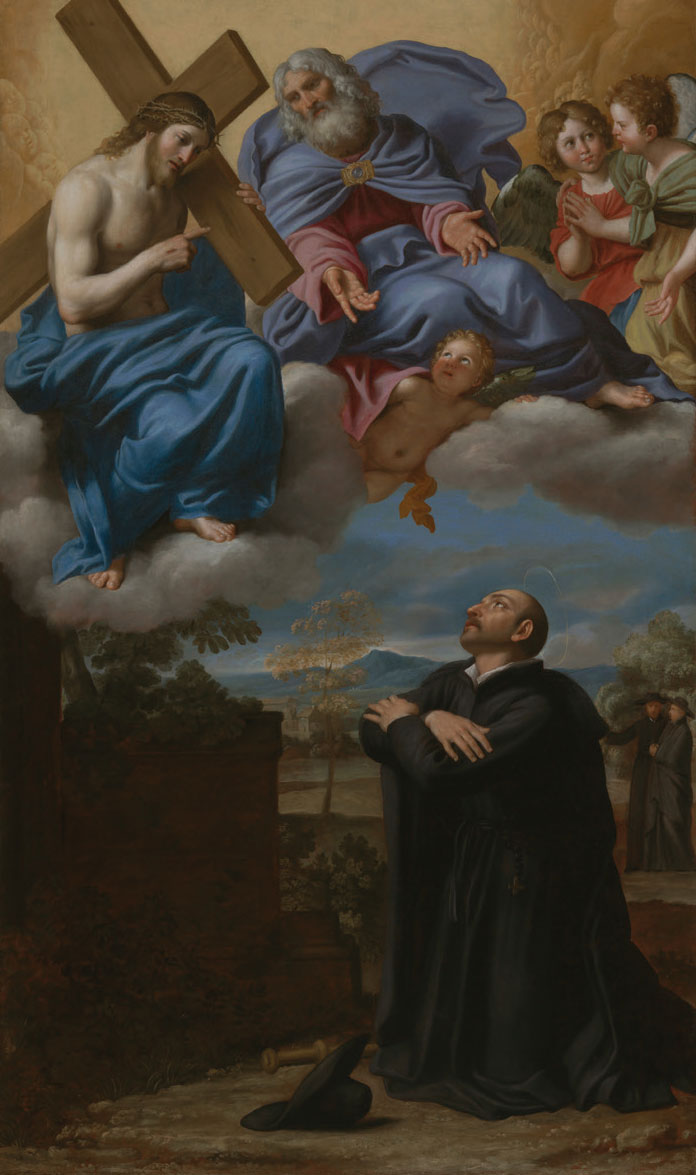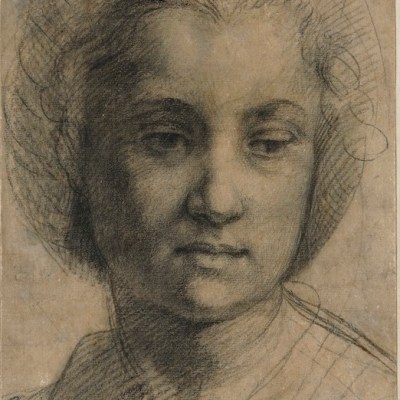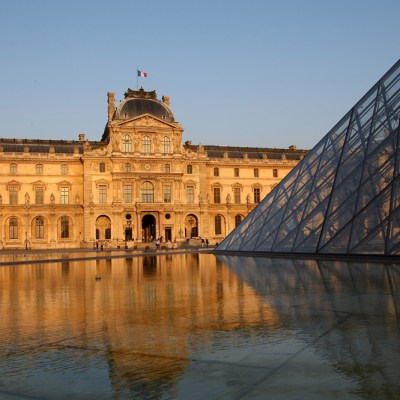The church of the Gesù rises at the foot of the ancient Capitoline Hill in the centre of Rome. Strategically sited, the imposing edifice loomed over the old Via Papalis, the main papal processional route that once ran through the city. The orientation of the Gesù on its small piazza, its single nave plan and barrel-vaulted ceiling, and the sober, elegant façade designed by the late Renaissance architect Giacomo della Porta (1532–1602) were all dictated by the church’s powerful and imperious benefactor, Cardinal Alessandro Farnese (1520–89), whose munificence is prominently commemorated in inscriptions on the exterior frieze and interior entrance wall. The Gesù is the mother church of the Society of Jesus, the religious order founded by Ignatius of Loyola in the charged climate that gave rise to the Counter-Reformation, and while that most venerated symbol of the Jesuits – IHS (the Holy Name of Jesus) – appears above the central portal, it is subordinate to the family name of the patron, FARNESIVS, which is foregrounded in the surmounting frieze. In this regard, the façade enshrines the fruitful yet fraught relations between the Jesuits and their great protector – a power struggle in which the wishes of the iron-willed cardinal invariably triumphed, and from which this glorious monument, a symbol of the Church resurgent, was born.
Bust of Cardinal Roberto Bellarmino (1621–24), Gian Lorenzo Bernini. Church of the Gesù, Rome. Photo: © Zeno Colantoni

This is one of the many plot lines explored in ‘The Holy Name – Art of the Gesù: Bernini and his Age’, which opens next month at the Fairfield University Art Museum (2 February–19 May) in celebration of the 75th anniversary of this Jesuit academic institution during the 2017–18 academic year. The exhibition presents five glorious masterpieces from the Gesù itself, augmented by some 50 paintings, sculptures, drawings, prints, rare books, documents, and objects from American public and private collections. Together, these chart the twinned narratives of the beginnings of the Society of Jesus and the long (and at times troubled) campaign to build and embellish its principal church. Headlining the exhibition is Bernini’s bust of Cardinal Roberto Bellarmino, which has never before left Rome. An early work by the sculptor, who had close ties with the Jesuits for much of his life, it is a strikingly sympathetic portrayal of this formidable antagonist of Giordano Bruno and Galileo. The sense of an animating spirit stirring within the stone anticipates Bernini’s conception of the ‘speaking likeness’. Other than the displaced inscription, the bust is the only surviving element of Bellarmino’s lost funerary monument. It usually resides in a niche high in the tribune of the Gesù, and is difficult to see; the exhibition offers an exceptional opportunity to view it close up and at eye level.
Alessandro Farnese’s patronage is represented in the exhibition by the sumptuous embroidered chasuble he gave to the church. Preserved there to this day, it is a rare surviving 16th-century ecclesiastical vestment. In a format that recalls manuscript illumination (Alessandro Farnese commissioned the famous Farnese Hours from the miniaturist Giulio Clovio), narrative fields and the cardinal’s coat of arms are framed by riotous foliated borders. The elaborate design also includes the papal insignia – a reference to the cardinal’s grandfather Pope Paul III Farnese (r. 1534–49), who approved the foundation of the Jesuit order in 1540. A papal bull bearing the pope’s lead seal, lent by the Morgan Library, dates from that propitious moment a few years before when Ignatius and his companions first reached Rome seeking papal favour. Among the signatories was Cardinal Alessandro, in whose conspicuous, florid and assertive signature it is tempting to read his privileged relationship to the pontiff.
Chasuble of Cardinal Alessandro Farnese (c. 1575–89). Church of the Gesù, Rome. Photo © Zeno Colantoni

Although their church was consecrated in 1584, the Jesuits had no saints until 1622, when Ignatius of Loyola and Francis Xavier were canonised – a momentous event that occasioned the dedication and furnishing of new altars in their honour. A shimmering gilt-bronze sculpture of St Teresa of Ávila from the altar of St Ignatius, designed by the versatile painter and draftsman Ciro Ferri, is another highlight of the exhibition. Ferri probably also vied for the commission to paint the altarpiece for the chapel of Francis Xavier, as a drawing in the Metropolitan Museum of Art seems to indicate, but the prize went to Carlo Maratti, author of an exuberant study of Francis Xavier in Glory from the Art Institute of Chicago (both in the exhibition). To frame the Latin text of the mass of St Ignatius, the German-born master Johann Adolf Gaap fabricated an ornate, jewel-encrusted cartegloria with cloud-born angels and instruments of the Passion framing a sunburst emblazoned with the IHS Christogram – one of the most stunning and important creations by any Roman baroque goldsmith to survive. This resplendent object, like Ciro Ferri’s St Teresa, speaks of the imperative to adorn the altars of the order’s first saints in order to promote their cults, thereby enhancing the prestige of the Jesuits and their church.
Saint Ignatius of Loyola’s Vision of Christ and God the Father at La Storta (c. 1622), Domenico Zampieri, called Domenichino. Los Angeles County Museum of Art Photo: Los Angeles County Museum of Art

The canonisations of the Society’s founders also gave rise to a new visual hagiography. The two key subjects, Ignatius’s vision at La Storta and the death of Francis Xavier, are depicted in luminous oil sketches by Giovanni Battista Gaulli (il Baciccio) in the exhibition. The earliest monumental treatment of Ignatius’s vision was almost certainly the altarpiece by Domenichino lent by the Los Angeles County Museum of Art, believed to have come from Cardinal Odoardo Farnese’s private chapel in the Casa Professa (the Jesuit residence). The robust, corporeal angels accompanying God the Father and Christ just overhead reflect the Jesuits’ belief in the immanence of angelic beings. Other saints and beati with less riveting biographies also entered the Jesuit pantheon and feature in the exhibition: from the Met comes a bronze relief designed by Alessandro Algardi for the funerary urn of Ignatius in the Gesù, showing the founders crowded together with other venerated early members of the Society. In the hands of the precociously brilliant sculptor Pierre Le Gros the Younger, and the imaginative painter, architect and scenographic designer Andrea Pozzo, their stories, too, become improbably thrilling.
The protagonists of the Gesù’s 17th-century history are Bernini, his protégé Gaulli, and the Superior General of the Society, Gian Paolo Oliva – the ‘forgotten celebrity of Baroque Rome’ according to historian Franco Mormando. Thanks to the loan of four exquisite oil sketches by Gaulli, including the magisterial bozzetto for the climactic Triumph of the Holy Name in the nave (Princeton University Art Museum), the exhibition offers a virtual experience of the entire frescoed interior, portal to tribune. The denouement is Gaulli’s monumental wood model of the apse, reunited for the first time with his painted sketch for the fresco – a vortex of colour and light (Fine Arts Museums of San Francisco).
Painted model for the apse fresco of the Gesù (1690), Giovanni Battista Gaulli. Church of the Gesù, Rome.

After some deliberation, and undoubtedly swayed by the persuasive Bernini, Oliva tapped Gaulli for the prestigious Gesù commission. Bernini guaranteed his disciple’s work; his involvement in the project is documented in drawings he made for the dome frescoes (the first stage of the campaign). Oliva was the Society’s great champion, a politically astute operator and compelling orator whose concern for his place in history is reflected in the published volumes of his writings with frontispieces designed by his friend Bernini. Like his predecessors a century earlier, Oliva had to deal with an overbearing – though far less beneficent – Farnese patron as he sought to realise his grand projet. The dazzling success of that enterprise may be admired in the Gesù and, for a few brief months, at the Fairfield University Art Museum.
‘The Holy Name – Art of the Gesù: Bernini and his Age’ is at Fairfield University Art Museum from 2 February until 19 May.
From the January 2018 issue of Apollo. Preview and subscribe here.

